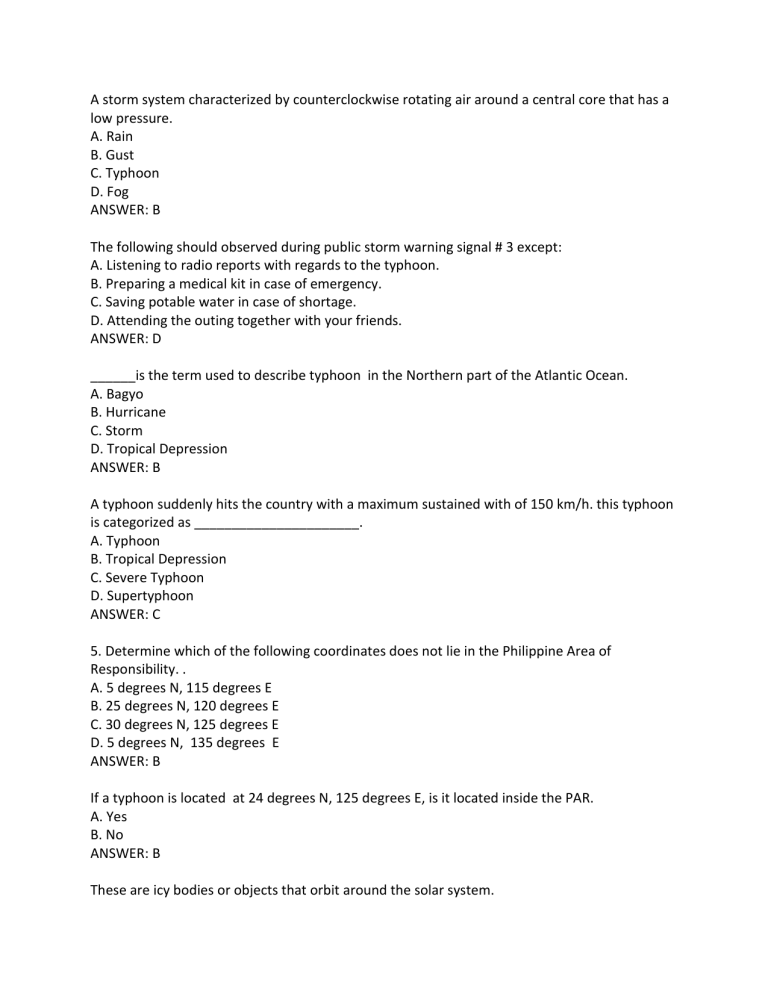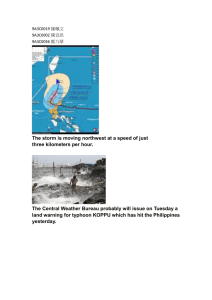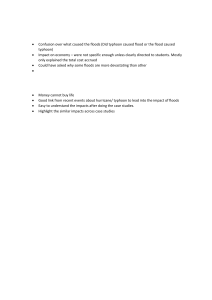
A storm system characterized by counterclockwise rotating air around a central core that has a low pressure. A. Rain B. Gust C. Typhoon D. Fog ANSWER: B The following should observed during public storm warning signal # 3 except: A. Listening to radio reports with regards to the typhoon. B. Preparing a medical kit in case of emergency. C. Saving potable water in case of shortage. D. Attending the outing together with your friends. ANSWER: D ______is the term used to describe typhoon in the Northern part of the Atlantic Ocean. A. Bagyo B. Hurricane C. Storm D. Tropical Depression ANSWER: B A typhoon suddenly hits the country with a maximum sustained with of 150 km/h. this typhoon is categorized as ______________________. A. Typhoon B. Tropical Depression C. Severe Typhoon D. Supertyphoon ANSWER: C 5. Determine which of the following coordinates does not lie in the Philippine Area of Responsibility. . A. 5 degrees N, 115 degrees E B. 25 degrees N, 120 degrees E C. 30 degrees N, 125 degrees E D. 5 degrees N, 135 degrees E ANSWER: B If a typhoon is located at 24 degrees N, 125 degrees E, is it located inside the PAR. A. Yes B. No ANSWER: B These are icy bodies or objects that orbit around the solar system. A. Meteorite B. Asteroid C. Comet D. Meteoroid ANSWER: C Which is most likely to make a more frequent visitor of earth? A. Meteorite B. Asteroid C. Comet D. Meteoroid ANSWER: A Which of the following types of meteorite does not belong to the group? A. Stony B. Stony - iron C. Iron D. Iron – rock ANSWER: D Where do typhoons and hurricane mostly formed? A. Pacific and Atlantic Ocean; south china sea B. Bering sea C. Arctic sea D. Indian ocean ANSWER: A Depending on strength, location, speed and direction, what are the different types of typhoons? A. Tropical depression B. Tropical storm C. Typhoon and hurricane D. All of the above ANSWER: B How does a cyclonic wind move in northern hemisphere? A. Clockwise B. Counter Clockwise C. Both D. North-South ANSWER: B What are the different paths of typhoons? A. Straight. A general westward path affects the Philippines, southern China, Taiwan and Vietnam. B. Recurving. Storms recurving affect eastern China, Taiwan, Korea and Japan. C. Northward. From the point of origin, the storm follows a northerly direction, only affecting small islands D. All of the above ANSWER: D What sector of the Philippine Government observes typhoons via radio satellite? A. Joint typhoon Warning System B. Philippine Atmospheric Geophysical And Astronomical Services Administration (PAGASA) C. Phil. Weather Administration D. None of the above ANSWER: B What typhoon signal with winds of 30-60 kph may be expected in at least 36 hours or intermittent rain may expected within 36 hours? A. 1 B. 2 C. 3 D. 4 ANSWER: A What typhoon signal characterized by winds greater than 60 kph up to 100 kph may be expected in at least 24 hours? A. 1 B. 2 C. 3 D. 4 ANSWER: 2 How is the weather in the “eye” of typhoon? A. Calm B. Intense C. Violent and windy D. Sunny ANSWER: A Wind speed is greater than 200 kph is _____ A. Supertyphoon B. Typhoon C. tropical storm D. Tropical depression ANSWER: A Wind speed is between 88-118 kph is ______ A. Supertyphoon B. Typhoon C. severe tropical storm D. Tropical depression ANSWER: C Which could develop into typhoon? A. low-pressure area over an ocean near a pole. B. High-pressure area over an ocean near a pole. C. Low-pressure area over an ocean near the equator. D. High-pressure area over an ocean near the equator. ANSWER: C What term refers to the tendency of a moving object (Including the wind) to be deflected to the right in the northern hemisphere and to the left in the southern hemisphere? A. Continental Drift B. Coriolis effect C. Doppler effect D. Equatorial drift ANSWER: B What ocean defines the boundary of the Philippines on the east? A. Arctic ocean B. Atlantic Ocean C. Indian Ocean D. Pacific Ocean ANSWER: D Which could happen when a typhoon moves onto land? A. Its supply of warm and moist air is increased, causing it to lose gain more strength. B. Its supply of warm and moist air is increased, causing it to lose its strength. C. Its supply of warm and moist air is cut off, causing it to gain more strength. D. Its supply of warm and moist air is cut off, causing it to lose strength. ANSWER: D Which are bodies that carry a streak of light as they move through Earth’s Atmosphere? A. comets B. meteors C. meteorites D. meteoroids ANSWER: B What is an atmosphere of gases and dusty particles produced from the sublimation of the icy outer part of the nucleus of the comet? A. Coma B. Corona C. Head D. Tail ANSWER: A What are regularly or irregularly shaped chunks of rocks that revolve around the sun in elliptical orbits mostly found between the orbits of mars and Jupiter? A. asteroids B. comets C. meteors D. meteoroids ANSWER: A Which is composed of ionized gas formed from comet’s gas ionized by ultraviolet photons from the sun? A. dust head B. dust tail C. plasma head D. Plasma tail ANSWER: D Composed mostly of silicate minerals, which is the most abundant type of meteorite? A. Charcoal B. Iron C. Stone D. Stony Iron ANSWER: C What is the estimated number of storms that enter the PAR every year? A. 23 B. 28 C. 10 D. 20 ANSWER: 20 Which of the following can weaken a typhoon? A. low vertical wind shear B. ocean water with 20 degree Celsius C. high humid area D. presence of ITCZ ANSWER: B The most active basin for the formation of tropical cyclone is the _____ A. Northwestern Pacific Ocean B. North Atlantic ocean C. Southeastern Ocean D. Southwestern Ocean ANSWER: A Which layer of the Earth’s atmosphere is associated with weather conditions? A. Mesosphere B. Troposphere C. Stratosphere D. Ionosphere ANSWER: B On 8 November 2013, Typhoon Yolanda, international code name _______, made landfall in the central Philippine islands region. The 600 km-diameter typhoon Yolanda crossed the Philippine archipelago, bringing widespread devastation in its path. A. Haiyan B. Goni C. Sendong D. Wili ANSWER: A Typhoon Rolly (international name _______) is the most powerful storm recorded worldwide this year. It first made landfall in the Philippines on 2 November 2020. A. Roli B. Goni C. Justine D. Gony ANSWER: B Typhoon _______, known in the Philippines as Typhoon Ulysses, was a powerful Category ... 12 hours before the typhoon's landfall, the PAGASA raised Signal #3 warnings for areas to be hit by the typhoon A. Haiyan B. Jane C. Vamco D. Leishe ANSWER: D On November 11, 2020, Typhoon Ulysses thrashed the Philippines with sustained winds of 150 kilometers (90 miles) per hour and peak intensity winds equivalent to a category 2 hurricane. The typhoon cut power to millions, caused more than 100,000 evacuations, and killed at least six people. The storm first made landfall in_____________________, around 10:30 p.m. and then continued west to hit the island of Luzon, where Manila saw its worst flooding in years. A river in Marikina, located in the Manila metropolitan area, was reported to have risen a meter (3 feet) in less than three hours. As of November 12, several dams were in danger of overflowing due to the heavy rains. A. Patnanungan, Quezon B. General Nakar, Quezon C. Polilio islands D. Babuyan Islands ANSWER: A



